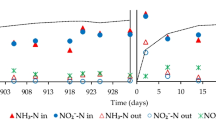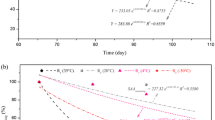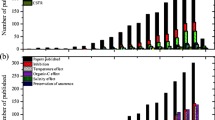Abstract
The anaerobic ammonium oxidation (anammox) process is a promising wastewater treatment method for biological nitrogen removal. A sufficient amount of active anammox sludge as a seed is crucial to the fast establishment and stability of the anammox process. Anammox bacteria is a kind of microorganism which is sensitive to the environmental conditions, e.g., oxygen, temperature. The optimum temperature and pH for the growth of the anammox bacteria are 30–40 °C and 6.7–8.3. A proper preservation technique allows fast start-up of the anammox process, overcoming the long doubling time of anammox biomass. The preservation of the anammox sludge is influenced by various factors, e.g., preservation techniques, duration, temperature, substrates, and protective agents. During preservation, the characteristics of the anammox biomass, including the bioactivity, heme c content, extracellular polymeric substances (EPS), and sludge morphology, change with time. The optimum preservation technique is not invariable and it depends on the purpose of preservation (precedence of bioactivity or quantity), the bacterial community, and other parameters. It is important for the preserved anammox biomass to achieve reactivation so that stable anammox reactors can be established as soon as possible. However, because the preservation process is complicated, the knowledge regarding preservation is far from complete, and much future work will be required to increase the understanding of preservation.


Similar content being viewed by others
References
Abma WR, Schultz CE, Mulder JW, van der Star WRL, Strous M, Tokutomi T, van Loosdrecht MCM (2007) Full-scale granular sludge anammox process. Water Sci Technol 55(8–9):27–33
Adav SS, Lee DJ, Tay JH (2007) Activity and structure of stored aerobic granules. Environ Technol 28:1227–1235
Agrawal LK, Jayadevan JY, Harada H, Nakamura K (1997) Utilization of dried pelletized anaerobic sludge for anaerobic treatment of wastewater. J Ferment Bioeng 83:91–95
Ali M, Chai LY, Tang CJ, Zheng P, Min XB, Yang ZH, Xiong L, Song YX (2013) The increasing interest of ANAMMOX research in China: bacteria, process development, and application. Biomed Res Int 134:914
Ali M, Oshiki M, Okabe S (2014) Simple, rapid and effective preservation and reactivation of anaerobic ammonium oxidizing bacterium “Candidatus Brocadia sinica”. Water Res 57:215–222
Ali M, Oshiki M, Rathnayake L, Ishii S, Satoh H, Okabe S (2015) Rapid and successful start-up of anammox process by immobilizing minimal quantity of biomass in PVA-SA gel beads. Water Res 79:147–157
Alvarez GS, Foglia ML, Copello GJ, Desimone MF, Diaz LE (2009) Effect of various parameters on viability and growth of bacteria immobilized in sol-gel-derived silica matrices. Appl Microbiol Biotechnol 82:639–646
Awata T, Oshiki M, Kindaichi T, Ozaki N, Ohashi A, Okabe S (2013) Physiological characterization of an anaerobic ammonium-oxidizing bacterium belonging to the “Candidatus scalindua” group. Appl Environ Microbiol 79:4145–4148
Batchelor SE, Cooper M, Chhabra SR, Glover LA, Stewart GS, Williams P, Prosser JI (1997) Cell density-regulated recovery of starved biofilm populations of ammonia-oxidizing bacteria. Appl Environ Microbiol 63:2281–2286
Bjerketorp J, Hakansson S, Belkin S, Jansson JK (2006) Advances in preservation methods: keeping biosensor microorganisms alive and active. Curr Opin Biotechnol 17:43–49
Chang J, Liu D, Cao HQ, Chang SX, Wang XY, Huang CC, Ge Y (2010) NO3 −/NH4 + ratios affect the growth and N removal ability of Acorus calamus and Iris pseudacorus in a hydroponic system. Aquat Bot 93:216–220
Chen H, Yu JJ, Jia XY, Jin RC (2014) Enhancement of anammox performance by cu(II), Ni(II) and Fe(III) supplementation. Chemosphere 117:610–616
Chen H, Hu HY, Chen QQ, Shi ML, Jin RC (2016) Successful start-up of the anammox process: influence of the seeding strategy on performance and granule properties. Bioresour Technol 211:594–602
Chen QQ, Chen H, Zhang ZZ, Guo LX, Jin RC (2017a) Effects of thiocyanide on granule-based anammox process and implications for regulation. J Hazard Mat 321:81–91
Chen QQ, Sun FQ, Guo Q, Shen YY, Jin RC (2017b) Process stability in an anammox UASB reactor with individual and combined thiocyanide and hydraulic shocks. Sep Purif Technol 173:165–173
Chiumenti A, da Borso F, Chiumenti R, Teri F, Segantin P (2013) Treatment of digestate from a co-digestion biogas plant by means of vacuum evaporation: tests for process optimization and environmental sustainability. Waste Manag 33:1339–1344
Cho S, Takahashi Y, Fujii N, Yamada Y, Satoh H, Okabe S (2010) Nitrogen removal performance and microbial community analysis of an anaerobic up-flow granular bed anammox reactor. Chemosphere 78:1129–1135
Cleland D, Krader P, Tang J, Emerson D (2001) Preservation of Acidithiobacillus by liquid-drying using glycine betaine as the cryoprotectant//proceedings of 101st general meeting for American Society for Microbiology. Orlando, 418.
Cleland D, Krader P, Mccree C, Tang J, Emerson D (2004) Glycine betaine as a cryoprotectant for prokaryotes. J Microbiol Meth 58:31–38
Dapena-Mora A, Fernandez I, Campos JL, Mosquera-Corral A, Mendez R, Jetten MSM (2007) Evaluation of activity and inhibition effects on anammox process by batch tests based on the nitrogen gas production. Enzyme Microb Tech 40:859–865
delas Heras A, de Lorenzo V (2011) In situ detection of aromatic compounds with biosensor Pseudomonas putida cells preserved and delivered to soil in water-soluble gelatine capsules. Anal Bioanal Chem 400:1093–1104
Deng LW, Zheng P, Chen ZA (2006) Anaerobic digestion and post-treatment of swine wastewater using IC-SBR process with bypass of raw wastewater. Process Biochem 41:965–969
Fessehaie A, Wydra K, Rudolph K (1999) Development of a new semiselective medium for isolating Xanthomonas campestris pv. manihotis from plant material and soil. Phytopathology 89:591–597
Gao DW, Yuan XJ, Liang H (2012) Reactivation performance of aerobic granules under different storage strategies. Water Res 46:3315–3322
Guo X, Zhao G, Sun T, Ji LS, Ma F (2017) Anaerobic ammonia oxidation mechanism of microbiology and its application in sewage denitrification process. World SCI-Tech R&D/http://www.Cnki.Net/kcms/detail/51.1468.N.20161223.1644.004.Html (in Chinese).
Hao XD, Heijnen JJ, van Loosdrecht MCM (2002) Model-based evaluation of temperature and inflow variations on a partial nitrification-ANAMMOX biofilm process. Water Res 36:4839–4849
Hays HCW, Milner PA, Jones JK, Rayner-Brandes MH (2005) Anoveland convenient self-drying system for bacterial preservation. J Microbiol Methods 63:29–35
Heylen K, Hoefman S, Vekeman B, Peiren J, Vos PD (2012) Safeguarding bacterial resources promotes biotechnological innovation. Appl Microbiol Biotechnol 94:565–574
Hsia TH, Feng YJ, Ho CM, Chou WP, Tseng SK (2008) PVA-alginate immobilized cells for anaerobic ammonium oxidation (anammox) process. J Ind Microbiol Biotechnol 35:721–727
Jetten MSM, Horn SJ, van Loosdrecht MCM (1997) Towards a more sustainable municipal wastewater treatment system. Water Sci Technol 35(9):171–180
Ji YX, Jin RC (2014) Effect of different preservation conditions on the reactivation performance of anammox sludge. Sep Puri Technol 133:32–39
Jin RC, Yang GF, Yu JJ, Zheng P (2012) The inhibition of the Anammox process: a review. Chem Eng J 197:67–79
Jin RC, Ma C, Yu JJ (2013) Performance of an Anammox UASB reactor at high load and low ambient temperature. Chem Eng J 232:17–25
Kartal B, Kuenen JG, van Loosdrecht MCM (2010) Sewage treatment with anammox. Science 238:702–703
Kartal B, van Niftrik L, Keltjens JT, Op den Camp HJ, Jetten MS (2012) Anammox-growth physiology, cell biology, and metabolism. Adv Microb Physiol 60:211–262
Kartal B, de Almeida NM, Maalcke WJ, Op den Camp HJM, Jetten MSM, Keltjens JT (2013) How to make a living from anaerobic ammonium oxidation. FEMS Microbiol Rev 37:428–461
Kridelbaugh D, Doerner KC (2009) Development of a defined medium for Clostridium scatologenes ATCC 25775. Lett Appl Microbiol 48:426–432
Krumnow AA, Sorokulova IB, Olsen E, Globa L, Barbaree JM, Vodyanoy VJ (2009) Preservation of bacteria in natural polymers. J Microbiol Methods 78:189–194
Kuppardt A, Chatzinotas A, Breuer U, van der Meer JR, Harms H (2009) Optimization of preservation conditions of as(III) bioreporter bacteria. Appl Microbiol Biotechnol 82:785–792
Laurin V, Labbe V, Juteau P, Parent S, Villemur R (2006) Long-term storage conditions for carriers with denitrifying biomass of the fluidized, methanol-fed denitrification reactor of the Montreal Biodome, and the impact on denitrifying activity and bacterial population. Water Res 40:1836–1840
Lay JJ, Li YY, Noike T (1997) Influence of pH and moisture content on the methane production in high-solids sludge digestion. Water Res 31:1518–1524
Li X, Zheng YH, Huang Y, Yuan Y (2011) Effect of preservation temperature and time on ANAMMOX sludge activity. China Environ Sci 31(1):56–61 (in Chinese)
Li JJ, Zicari SM, Cui ZJ, Zhang RH (2014) Processing anaerobic sludge for extended storage as anaerobic digester inoculum. Bioresour Technol 166:201–210
Lotti T, Kleerebezem R, Hu Z, Kartal B, Jetten MSM, van Loosdrecht MCM (2014) Simultaneous partial nitritation and anammox at low temperature with granular sludge. Water Res 66:111–121
Ma B, Wang SY, Cao SB, Miao YY, Jia FX, Du R, Peng YZ (2016) Biological nitrogen removal from sewage via anammox: recent advances. Bioresour Technol 200:981–990
Magrí A, Vanotti MB, Szögi AA (2012) Anammox sludge immobilized in polyvinyl alcohol (PVA) cryogela carriers. Bioresour Technol 114:231–240
Manchee RJ (1975) Long term storage of Thiobacillus ferrooxidans. J Appl Bact 38:191–192
Marie PS, Pumpel T, Markt R, Murthy S, Bott C, Wett B (2015) Comparative evaluation of multiple methods to quantify and characterize granular anammox biomass. Water Res 68:194–205
McSwain BS, Irvine RL, Hausner M, Wilderer PA (2005) Composition and distribution of extracellular polymeric substances in aerobic flocs and granular sludge. Appl Environ Microbiol 71:1051–1057
Mihoubi D (2004) Mechanical and thermal dewatering of residual sludge. Desalination 167:135–139
Min XB, Zhou M, Chai LY, Wang YY, Shu YD (2009) Treatment of nickel-ammonia complex ion-containing ammonia nitrogen wastewater. Tran Nonferr Metals Soc China 100:2171–2175
Miyamoto-Shinohara Y, Sukenobe J, Imaizumi T, Nakahara T (2008) Survival of freeze-dried bacteria. J Gen Appl Microbiol 1:9–24
Mobarry BK, Wagner M, Urbain V, Rittmann BE, Stahl DA (1996) Phylogenetic probes for analyzing abundance and spatial organization of nitrifying bacteria. Appl Environ Microbiol 62:2156–2162
Morgan CA, Herman N, White PA, Vesey G (2006) Preservation of micro-organisms by drying: a review. J Microbiol Methods 66:183–193
Rehl T, Müller J (2011) Life cycle assessment of biogas digestate processing technologies. Resour Conserv Recycl 56:92–104
Rothrock MJ Jr, Vanotti MB, Szoegi AA, Garcia Gonzalez MC, Fujii T (2011) Long-term preservation of anammox bacteria. Appl Microbiol Biotechnol 92:147–157
Scaglione D, Caffaz S, Bettazzi E, Lubello C (2009) Experimental determination of Anammox decay coefficient. J Chem Technol Biotechnol 84:1250–1254
Shen LD, Hu AH, Jin RC, Cheng DQ, Zheng P, Xu XX, Hu BL (2012) Enrichment of anammox bacteria from three sludge source for the startup of monosodium glutamate industrial wastewater treatment system. J Hazard Mater 199-200:193–199
Stacey GN, Day JG (2007) Long-term exsitu conservation of biological resources and the role of biological resource centers. In: Day JG, Stacey GN (eds) Cryopreservation and freeze-drying protocols, 2nd edn. Humana Press, Totowa, pp 1–14
Strous M, Heijnen JJ, Kuenen JG, Jetten MSM (1998) The sequencing batch reactor as a powerful tool for the study of slowly growing anaerobic ammonium oxidizing microorganisms. Appl Microbiol Biotechnol 50:589–596
Strous M, Kuenen G, Jetten M (1999) Key physiology of anaerobic ammonium oxidation. Appl Environ Microbiol 65:3248–3250
Su KZ, Yu HQ (2005) Formation and characterization of aerobic granules in a sequencing batch reactor treating soybean-processing wastewater. Environ Sci Technol 39:2818–2827
Tang CJ, Zheng P, Wang CH, Mahmood Q (2010) Suppression of anaerobic ammonium oxidizers under high organic content in high-rate Anammox UASB reactor. Bioresour Technol 101:1762–1768
Tang CJ, Duan CS, Yu C, Song YX, Chai LY, Xiao RY, Wei ZS, Min XB (2017) Removal of nitrogen from wastewaters by anaerobic ammonium oxidation (ANAMMOX) using granules in upflow reactors. Environ Chem Lett. doi:10.1007/s10311-017-0607-5
Tsushima I, Ogasawara Y, Kindaichi T, Satoh H, Okabe S (2007) Development of high-rate anaerobic ammonium oxidizing (anammox) biofilm reactors. Water Res 41:1623–1634
van de Graaf AA, de Bruijin P, Roertson LA, Jetten MSM, Kuenen JG (1996) Autotrophic growth of anaerobic ammonium-oxidizing micro-organisms in a fluidized bed reactor. Microbiology 142:2187–2196
van der Star WRL, Abma WR, Blommers D, Mulder JW, Tokutomi T, Strous M, Picioreanu C, van Loosdrecht MCM (2007) Startup of reactors for anoxic ammonium oxidation: experiences from the first full-scale anammox reactor in Rotterdam. Water Res 41:4149–4163
van der Star WR, Miclea AI, van Dongen UG, Muyzer G, Picioreanu C, van Loosdrecht MCM (2008) The membrane bioreactor: a novel tool to grow anammox bacteria as free cells. Biotechnol Bioeng 101:286–294
van Hulle SWH, Vandeweyer HJP, Meesschaert BD, Vanrolleghem PA, Dejans P, Dumoulin D (2010) Engineering aspects and practical application of autotrophic nitrogen removal from nitrogen rich streams. Chem Eng J 162:1–20
van Loosdrecht MCM (2008) Innovative nitrogen removal. In: Henze M, van Loosdrecht MCM, Ekama GA, Brdjanovic D (eds) Biological wastewater treatment: principles, Modeling and Design. IWA Publishing, London, pp 139–154
Vlaeminck SE, Geets J, Vervaeren H, Boon N, Verstraete W (2007) Reactivation of aerobic and anaerobic ammonium oxidizers in OLAND biomass after long-term storage. Appl Microbiol Biotechnol 74:1376–1384
Wagner M, Rath G, Koops HP, Flood J, Amann R (1996) In situ analysis of nitrifying bacteria in sewage treatment plants. Water Sci Technol 34(1–2):237–244
Wang ZW, Liu Y, Tay JH (2005) Distribution of EPS and cell surface hydrophobicity in aerobic granules. Appl Microbiol Biotechnol 69:469–473
Wang CH, Zheng P, Cai J, Chen TT (2013) Preservation of ANAMMOX bacteria. China Environ. Sci 33(8):1474–1482 (in Chinese)
Watkin ELJ, Keeling SE, Perrot FA, Shiers DW, Palmer ML, Watling HR (2009) Metals tolerance in moderately thermophilic isolates from a spent copper sulfide heap, closely related to Acidithiobacilluscaldus, Acidimicrobium ferrooxidans and Sulfobacillus thermosulfidooxidans. J Ind Microbiol Biot 36:461–465
Withers PJA, Jarvie HP, Stoate C (2011) Quantifying the impact of septic tank systems on eutrophication risk in rural headwaters. Environ Int 37:644–653
Wu XL, Xin XH, Jiang Y, Liang RX, Yuan P, Fang CX (2008) Liquid-nitrogen cryopreservation of three kinds of autotrophic bioleaching bacteria. Tran Nonferrous Met Soc China 18:1386–1391
Wu XL, Hu Q, Hou DM, Xin XH, Miao B, Wang YY, Liu XD, Shen L (2013) Preservation efficiency of new cryoprotectant used for Acidithiobacillus ferrooxidans in liquid nitrogen. Trans Nonferrous Met Soc China 23:818–823
Xing BS, Guo Q, Jiang XY, Chen QQ, He MM, Wu LM, Jin RC (2016) Long-term starvation and subsequent reactivation of anaerobic ammonium oxidation (anammox) granules. Chem Eng J 287:575–584
Yang Y, Zhang YF, Huang JF, Jiang DH, Chen Y, Qiu GZ (2006a) Preservation of Acidithiobacillus ferrooxidans. J Cent South Univ (Sci Technol) 37:472–475 (in Chinese)
Yang Y, Zhang YF, He H, Wan MX, Shi WY, Qiu GZ (2006b) Optimization of frozen storage cryoprotectant for Acidithiobacillus ferroxidans by orthogonal experiment. J Cent South Univ 37:891–895 (in Chinese)
Yu JJ, Chen H, Zhang J, Ji YX, Liu QZ, Jin RC (2013) Enhancement of ANAMMOX activity by low-intensity ultrasound irradiation at ambient temperature. Bioresour Technol 42:693–696
Zeng WM, Zhou HB, Wan MX, Chao WL, Xu AL, Liu XD, Qiu GZ (2009) Preservation of Acidithiobacillus caldus: a moderately thermophilic bacterium and the effect on subsequent bioleaching of chalcopyrite. Hydrometallurgy 96:333–336
Zhang LL, Zhang B, Huang YF, Cai WM (2005) Re-activation characteristics of preserved aerobic granular sludge. J Environ Sci 17:655–658
Zhang QQ, Chen H, Liu JH, Yang BE, Ni WM, Jin RC (2014) The robustness of ANAMMOX process under the transient oxytetracycline (OTC) shock. Bioresour Technol 153:39–46
Zheng YH, Li X, Huang Y (2011) Study on the influence of preservation temperature on activity of ANAMMOX sludge. Environ Pollut Control 35:82–86 (in Chinese)
Zhou Y, Oehmen A, Lim M, Vadivelu V, Ng WJ (2011) The role of nitrite and free nitrous acid (FNA) in wastewater treatment plants. Water Res 45:4672–4682
Acknowledgements
The authors wish to thank the Natural Science Foundation of China (Nos.51578204 and 51278162) for their partial support of this study.
Author information
Authors and Affiliations
Corresponding author
Ethics declarations
Funding
This study was funded by the Natural Science Foundation of China (Nos.51578204 and 51278162).
Conflict of interest
The authors declare that they have no conflict of interest.
Ethical approval
This article does not contain any studies with human participants or animals performed by any of the authors.
Electronic supplementary material
ESM 1
(PDF 591 kb)
Rights and permissions
About this article
Cite this article
Chen, H., Jin, RC. Summary of the preservation techniques and the evolution of the anammox bacteria characteristics during preservation. Appl Microbiol Biotechnol 101, 4349–4362 (2017). https://doi.org/10.1007/s00253-017-8289-2
Received:
Revised:
Accepted:
Published:
Issue Date:
DOI: https://doi.org/10.1007/s00253-017-8289-2




